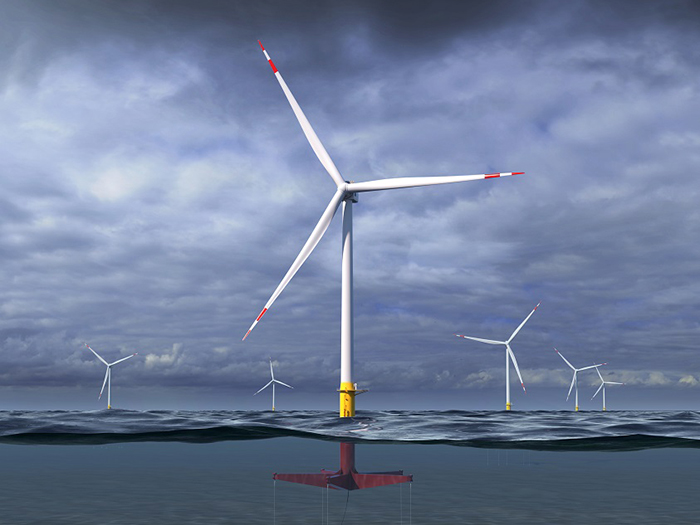
Clarksons sees potential for 1,300 floating wind turbines by 2030
Written by Nick Blenkey
Developing California offshore wind will demand floating turbines: An artist’s rendering of the 12 MW floating wind turbine concept GE Research and Glosten are designing as part of a project with ARPA-E. [Image Glosten]
A new briefing on floating offshore wind from Clarksons Research sees a global potential for 14.5 GW and 1,300 turbines by 2030.
Released onto the Clarksons Renewables Intelligence Network, the briefing profiles the prospects for growth in the sector, examining capacity trends, the maritime supply chain and key projects in the industry.
Steve Gordon, managing director of Clarksons Research comments:
- While “floating wind” is only a small part of the offshore wind industry today (only 10 projects of 124 MW are active, with a further 8 projects of 165 MW under construction), strong growth is expected from the middle of the 2020s as the sector reaches commercialization (our projections suggest that 96 farms, 14.5 GW, 1,300 turbines could be active by 2030).
- Floating wind is likely to open up new regional markets, where development has so far been unfeasible.
- Countries with significant numbers of floating wind projects already proposed include the U.K. (31.1 GW), Australia (13.8 GW) and the U.S. (10.7 GW). Over 150 potential floating offshore wind projects (totalling over 100 GW) have been proposed by developers in 21 countries/regions, with 37 of these projects having nameplate capacities >1 GW.
- As the floating sector moves towards commercialization, the industry has proposed a wide variety of foundation designs (at least 12 so far). Semi-sub foundations are most common in projects proposed to date (over 1,200 proposed, compared to the combined ~350 across Spar, barge and TLP turbines solutions).
- Floating wind poses new installation challenges for developers and Clarksons’ analysis examines which contractors and yards have already been active in the sector, as well as profiling the demands on the installation and support fleet, port infrastructure and the unique maintenance requirements of floating wind farms.
- Leading developers of floating wind to date include Equinor (2 farms, 32 MW active, with 1 farm / 88 MW under development), Cobra (2 farms, 50 MW active), Ocean Winds (1 farm, 30 MW active) and Windplus (1 farm, 25 MW active). In terms of potential capacity, leading developers include BlueFloat (8.5 GW), Hexicon (7.7 GW), Oceanex (7.4 GW), Aqua Ventus (5.1 GW) and Scottish Power (5.0 GW). Contractors involved in turbine installation to date have included DOF Subsea (11 turbines under development), Saipem (5 turbines installed) , Bourbon (5) and Boskalis (5).
- The broader offshore wind industry continues its exciting growth phase and our long term scenarios suggest offshore wind will play a vital role in energy transition and may provide between 6% and 9% of global energy supply by 2050 (it is 0.3% today).
Categories: News, Offshore Wind




